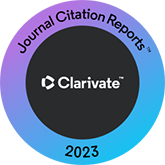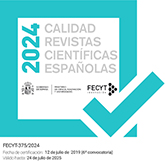Adquisición del ritmo en L2 y transferencia rítmica en aprendices gallegos de inglés: un estudio piloto
DOI:
https://doi.org/10.3989/loquens.2022.087Palabras clave:
Transferencia rítmica, aprendizaje de ritmo L2, ritmo del inglés, métricas de ritmoResumen
Las lenguas se han clasificado con respecto a su ritmo como lenguas de ritmo acentual, silábico o moraico. El objetivo de este estudio piloto es verificar la existencia de transferencia rítmica de una lengua de ritmo silábico, el gallego (L1), al inglés hablado por estudiantes gallegos (L2), así como determinar si el nivel de competencia en la L2 puede tener un efecto sobre el grado de transferencia rítmica observado. Se registraron y analizaron dos grupos de seis hablantes nativos de gallego, por un lado, y seis hablantes de inglés del Sur de Gran Bretaña, por otro. Se calcularon las métricas de ritmo (ΔC, %V, ΔV, CrPVI y VnPVI) para los cuatro grupos a fin de tener medidas objetivas para comparar el ritmo del idioma de origen (gallego), el ritmo del idioma de destino (inglés) y el ritmo del idioma del alumnado con diferentes niveles de competencia. Los datos muestran que existe transferencia rítmica entre el gallego y el inglés L2, y que el grado de transferencia disminuye a medida que aumenta el nivel de competencia en la L2.
Descargas
Citas
Abercrombie, D. (1967). Elements of General Phonetics. Edinburgh: Edinburgh University Press.
Arvaniti, A. (2012). The usefulness of metrics in the quantification of speech rhythm. Journal of Phonetics, 40, 351-373. https://doi.org/10.1016/j.wocn.2012.02.003
Arvaniti, A. (2009). Rhythm, timing and the timing of rhythm. Phonetica, 66(1-2), 46-63. https://doi.org/10.1159/000208930 PMid:19390230 PMCid:PMC2790788
Bertinetto P.M. (1989). Reflections of the dichotomy "stress" vs. "syllable-timing". Revue de Phonétique Appliquée, 91-93, 99-130.
Boersma, P. & Weenink, D. (2019). Praat: Doing phonetics by computer [Computer program]. Version 6.1.07, retrieved from http://www.praat.org/
Bond, Z.S. & Fokes, J. (1985). Non-native pattern of English syllable-timing. Journal of Phonetics, 13, 407-420. https://doi.org/10.1016/S0095-4470(19)30786-7
Broselow, E. & Kang, Y. (2013). Second language phonology and speech. In Herschensohn, J. & M. Young-Scholten (Eds.), The Cambridge Handbook of Second Language Acquisition (pp. 529-554). Cambridge: Cambridge University Press. https://doi.org/10.1017/CBO9781139051729.031
Brown, H. (2000). Principles of Language Learning and Teaching. London: Pearson Education.
Bunta, F. & Ingram, D. (2007). The acquisition of speech rhythm by bilingual Spanish- and English-speaking 4- and 5-year-old children. Journal of Speech, Language, and Hearing Research, 50(4), 999-1014. https://doi.org/10.1044/1092-4388(2007/070) PMid:17675601
Celce-Murcia, M. (Ed.) (1991). Teaching English as a Second or Foreign Language (2nd ed.). Boston, MA: Heinle & Heinle Publishers.
Council of Europe. (2001). Common European framework of reference for languages: Learning, teaching, assessment. Cambridge: Press Syndicate of the University of Cambridge.
Dauer, R. (1983). Stress-timing and syllable-timing reanalyzed. Journal of Phonetics, 11, 51-62. https://doi.org/10.1016/S0095-4470(19)30776-4
Dellwo, V. (2006). Rhythm and Speech Rate: A Variation Coefficient for deltaC. In P. Karnowski & I. Szigeti (Eds.), Language and Language-processing (pp. 231-241). Bern: Peter Lang.
Eckman, F.R. (2012). Second language phonology. In S. M. Gass & A. Mackey (Eds.), The Routledge Handbook of Second Language Acquisition (pp. 91-105). London: Routledge.
Espinosa, G.E. (2019). English speech rhythm in instructed learners. Its development as shown by VarcoV. In G. E. Espinosa, M. Fernández Beschtedt, P. A. Formiga, & M. A. Verdú (Eds.), Conocimiento y diversidad en el estudio y la enseñanza de lenguas, Neuquén: Universidad Nacional del Comahue (pp. 204-212). Retrieved from http://bibliotecadelenguas.uncoma.edu.ar/items/show/426
Espinosa, G.E. (2018). La adquisición del ritmo inglés por hablantes nativos de español. El caso de aprendientes argentinos en contexto de instrucción formal [Unpublished PhD thesis]. Buenos Aires: Universidad de Buenos Aires, Argentina.
Flege, J.E., Schirru, C., & MacKay, I.R.A. (2003). Interaction between the native and second language phonetic subsystems. Speech Communication, 40, 467-491. https://doi.org/10.1016/S0167-6393(02)00128-0
Gabriel, C., & Kireva, E. (2014). Speech rhythm and vowel raising in Bulgarian Judeo-Spanish. In N. Campbell, D. Gibbon, & D. Hirst (Eds.), Proceedings of Speech Prosody 2014 (pp. 728-732). https://doi.org/10.21437/SpeechProsody.2014-134
Gass, S.M. & Selinker, L. (2008). Second Language Acquisition: An Introductory Course (3rd edition). London: Routledge. https://doi.org/10.4324/9780203932841
Grabe, E. & Low E.L. (2002). Durational variability in speech and the rhythm class hypothesis. In C. Gussenhoven & N. Warner (Eds.), Papers in Laboratory Phonology 7 (pp. 515-546). Berlin: De Gruyter. https://doi.org/10.1515/9783110197105.2.515
Grenon, I. & White, L. (2008). Acquiring rhythm: A comparison of L1 and L2 speakers of Canadian English and Japanese. Proceedings of the 32nd Boston University conference on language development (pp. 155-166). Boston: Boston University.
Gutiérrez Díez, F., Dellwo, V., Gavaldà, N., & Rosen, S. (2008). The development of measurable speech rhythm during second language acquisition. The Journal of the Acoustical Society of America, 123. https://doi.org/10.1121/1.2935815
Gut, U. (2012). Rhythm in L2 speech. Speech and language technology, 14/15, 83-94.
IPA (1999). Handbook of the International Phonetic Association. A Guide to the Use of the International Phonetic Alphabet. Cambridge: Cambridge University Press.
James, A. (1988). The Acquisition o f a Second Language Phonology. Tübingen: Narr.
Kennedy, S. & Trofimovich, P. (2010). Language awareness and second language pronunciation: A classroom study. Language Awareness, 19, 171-185. https://doi.org/10.1080/09658416.2010.486439
Kinoshita, K. & Sheppard, C. (2011). Validating acoustic measures of speech rhythm for second language acquisition. In W. S. Lee & E. Zee (Eds.), Proceedings of the 17th International Congress of Phonetic Sciences (pp. 1086-1089). Hong Kong: City University of Hong Kong.
Kireva, E. & Gabriel, C. (2015). Rhythmic properties of a contact variety: Comparing read and semi-spontaneous speech in Argentinean Porteño Spanish. In M. Avanzi, E. Delais-Roussarie & S. Herment (Eds.), Prosody and Languages in Contact (pp. 149-168). Berlin: Springer. https://doi.org/10.1007/978-3-662-45168-7_8
Kohler, K.J. (2009). Rhythm in speech and language. Phonetica, 66(1-2), 29-45. https://doi.org/10.1159/000208929 PMid:19390229
Leather, J. & James, A. (1991). The acquisition of second language speech. Studies in Second Language Acquisition, 13, 305-341. https://doi.org/10.1017/S0272263100010019
Li, A. & Post, B. (2014). L2 acquisition of prosodic properties of speech rhythm: Evidence from L1 Mandarin and German learners of English. Studies in Second Language Acquisition, 36(2), 223-255. https://doi.org/10.1017/S0272263113000752
Mairano, P. & Romano, A. (2010). Un confronto tra diverse metriche ritmiche usando Correlatore. In S. Schmid, M. Schwarzenbach, & D. Studer (Eds.), La dimensione temporale del parlato (pp. 79-100). Bern: EDK.
Major, R.C. (2008). Transfer in Second Language Phonology - A review. In J. G. Hansen Edwards & M. L. Zampini (Eds.), Phonology and second language acquisition, Studies in Bilingualism (pp. 63-94). Amsterdam: John Benjamins. j https://doi.org/10.1075/sibil.36.05maj
Ordin, M. & Polyanskaya, L. (2014). Development of timing patterns in first and second languages. System, 42, 244-257. https://doi.org/10.1016/j.system.2013.12.004
Ordin, M. & Polyanskaya, L. (2015a). Acquisition of speech rhythm in a second language by learners with rhythmically different native languages. The Journal of the Acoustic Society of America, 138(2), 533-545. https://doi.org/10.1121/1.4923359 PMid:26328670
Ordin, M. & Polyanskaya, L. (2015b). Acquisition of English speech rhythm by monolingual children. In INTERSPEECH-2015 (pp. 3120-3124). https://doi.org/10.21437/Interspeech.2015-628
Payne, E., Post, B., Astruc, Ll., Prieto, P. & Vanrell, M.M. (2012). Measuring child rhythm. Language and Speech, 55(2), 203-229. https://doi.org/10.1177/0023830911417687 PMid:22783632
Pike, K. (1945). The Intonation of American English. Ann Arbor, MI: University of Michigan Press.
Polyanskaya, L., Ordin, M., & Busa, M.G. (2016). Relative salience of speech rhythm and speech rate on perceived foreign accent in a second language. Language and Speech, 60(3), 333-355. https://doi.org/10.1177/0023830916648720 PMid:28915779
Prieto, P., Vanrell, M.M., Astruc, Ll., Payne, E., & Post B. (2012). Phonotactic and phrasal properties of speech rhythm. Evidence from Catalan, English, and Spanish. Speech Communication, 54(6), 681-702. https://doi.org/10.1016/j.specom.2011.12.001
Ramus, F. (2002). Acoustic correlates of linguistic rhythm: Perspectives. In B. Bel & I. Marlien (Eds.), Proceedings of Speech Prosody 2002 (pp. 115-130). Aix-en-Provence: Université de Provence.
Ramus, F., Nespor, M., & Mehler, J. (1999). Correlates of linguistic rhythm in the speech signal. Cognition, 73, 265-292. https://doi.org/10.1016/S0010-0277(99)00058-X PMid:10585517
Rasier, L. & Hiligsmann, Ph. (2007). Prosodic transfer. Theoretical and issues. Nouveaux cahiers de linguistique Franτaise, 28, 41-66.
Rathcke, T.V. & Smith, R.H. (2015). Speech timing and linguistic rhythm: On the acoustic bases of rhythm typologies. The Journal of the Acoustical Society of America, 137(5), 2834-2845. https://doi.org/10.1121/1.4919322 PMid:25994711
Roseano, P. (2021). Splitting the rhythmic continuum in rhythmic classes: An HCA approach [Poster presentation]. 4th Phonetics and Phonology in Europe (PaPE), June 21-23. Barcelona, Spain.
Ross, T., Ferjan, N., & Arvaniti, A. (2008). On the reliability of rhythm metrics. The Journal of the Acoustical Society of America, 124, 2495. https://doi.org/10.1121/1.4782810
Ryu, Y. (2002). Pronunciation of English as a second or foreign language learners [sic]: the reexamination of teaching pronunciation [Unpublished MA dissertation]. Missoula, USA: The University of Montana.
Scovel, T. (1988). A Time to Speak: A Psycholinguistic Inquiry into the Critical Period for Human Speech. Cork, Ireland: Newbury House.
Scovel, T. (1969). Foreign accents, language acquisition and cerebral dominance. Language Learning, 25, 209-235.
Tsiartsioni, E. (2011). Can pronunciation be taught? Teaching English speech rhythm to Greek students. In E. Kitis, N. Lavidas, N. Tpointzi, & T. Tsangalidis (Eds.), Proceedings of the 19th International Symposium on Theoretical and Applied Linguistics (ISTAL) (pp. 447-458). Tesalonica: Aristotle University of Thessaloniki.
Van Maastricht, L., Krahmer, E., Swerts, M., & Prieto, P. (2019). Learning direction matters: A study on L2 rhythm acquisition by Dutch learners of Spanish and Spanish learners of Dutch. Studies in Second Language Acquisition, 41(1), 87-121. https://doi.org/10.1017/S0272263118000062
Wenk, B. (1986). Crosslinguistic influence in sound language phonology: Speech rhythms. In E. Kellerman & M. Sharwood Smith (Eds.). Crosslinguistic Influence in Second Language Acquisition (pp. 120-133). Oxford: Pergamon Press Ltd.
White, L. & Mattys, S.L. (2007a) Rhythmic typology and variation in first and second languages. In P. Prieto, Mascaró, & M.J. Solé (Eds.) Segmental and Prosodic Issues in Romance Phonology (pp. 237-257). Amsterdam: John Benjamins. https://doi.org/10.1075/cilt.282.16whi
White, L. & Mattys, S.L. (2007b). Calibrating rhythm: First language and second language studies. Journal of Phonetics, 35(4), 501-522. https://doi.org/10.1016/j.wocn.2007.02.003
Publicado
Cómo citar
Número
Sección
Licencia
Derechos de autor 2023 Consejo Superior de Investigaciones Científicas (CSIC)

Esta obra está bajo una licencia internacional Creative Commons Atribución 4.0.
© CSIC. Los originales publicados en las ediciones impresa y electrónica de esta Revista son propiedad del Consejo Superior de Investigaciones Científicas, siendo necesario citar la procedencia en cualquier reproducción parcial o total.Salvo indicación contraria, todos los contenidos de la edición electrónica se distribuyen bajo una licencia de uso y distribución “Creative Commons Reconocimiento 4.0 Internacional ” (CC BY 4.0). Puede consultar desde aquí la versión informativa y el texto legal de la licencia. Esta circunstancia ha de hacerse constar expresamente de esta forma cuando sea necesario.
No se autoriza el depósito en repositorios, páginas web personales o similares de cualquier otra versión distinta a la publicada por el editor.














